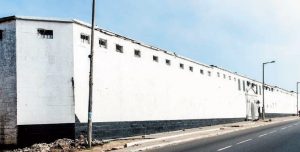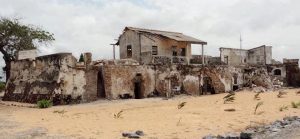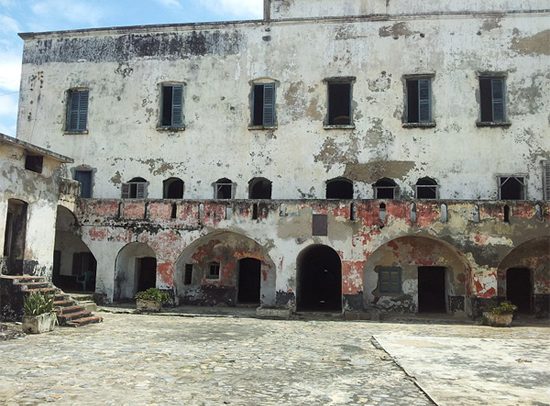Fort William – Anomabu
Ghana has the greatest concentration of colonial-era forts than any country in Africa and world.
The most visited destinations are the colonial fortresses at Cape Coast and Elmina, which were once major shipping points for tens of thousands of slaves.
There are also many smaller forts. Some are in a state of ruin while others are maintained and provide basic tours.
For two weeks now, NEWS-ONE has been highlighting some of the forts which are serving great tourism purposes and more.
This week, we bring to the attention of tourists visiting Ghana more of these amazing destinations. This is part of an initiative by the office of the Ministry of Tourism Arts & Culture to guide tourists to the best destinations in Ghana.
Fort Dorothea, Akwidaa
In 1683, the Brandenburger Company built a lodge in Akwida, east of Cape Three Points in the Western Region of Ghana, in 1683. Fort Dorothea was originally built as a small triangular building. Situated on a promontory and the end of a peninsula between the mouth of the Suni River and the sea, it had much natural protection. The lodge was captured in 1690 and enlarged into a fort by the Dutch. It was renamed Fort Dorothea. It is currently preserved as a ruin and tourists are welcomed to see it.
Fort Victoria, Cape Coast
Fort Victoria is situated on a hill in Cape Coast. The first fort on this hill was built in 1712. It was named after its builder— Phipp’s Tower. It was one of a chain of three lookout posts built on the hills in the town of Cape Coast around Cape Coast Castle, which were used for protecting the castle against Ashanti attacks and signalling purposes. This little round tower mounted seven cannons but fell to ruin later in the 18th century.
In 1837, the present Fort Victoria was built on the ruins of its predecessor as a small but strong fort.
Fort Victoria is freely accessible, although if you take the road up the hill past the Mighty Victory Hotel you could be expected to pay a small token. The fort seems not to be used for anything. Fort Victoria was named after Queen Victoria of Great Britain.
Perched on a hill on the western part of the Cape Coast township in the Central Region, the fort overlooks both the Atlantic Ocean and the historic town. Fort Victoria has been preserved as a monument. The fort is in a respectable condition. The fort’s opening hours are 9:00am to 4:30pm. Visitors are warmly welcome to see the fort.
Fort Apollonia
Until 1670, there was no fort west of the River Ankobra in Beyin in the Western Region of Ghana, except for the temporary French fort at Assini. All goods – gold and slaves – were brought to the coast, where captains of all nationalities haggled fervently for it.
To ward off Dutch colonial ambitions which had lead to intermittent warfare in the Nzema area (Apollonia) and to facilitate trade, the Nzema chief (Amenihyia) granted the English Committee of Merchants permission to build a fort at Beyin on an elevated platform known as Cape Apollonia.
In 1766, the quest for building materials began; construction ensued two years later on the last fort in the Gold Coast to be built by the English. The name of the fort was first bestowed on the area by a Portuguese explorer who first caught sight of the place on St. Apollonia’s Day.
The abolition of the slave trade diminished the economic importance of the fort, and hence it was abandoned in 1819. It was transferred to the Dutch in 1868 as part of the 1867 exchange of forts agreement between the British and the Dutch. The Dutch renamed it in honour of their monarch, Willem III, and held it until 1872, when it reverted to the British.
The fort was bombarded by a British gunboat in 1873 during a British attack on Beyin on account of its coalition with the Asante Kingdom. The fort fell to ruins. It was rehabilitated in the 1960s by the Ghana Museums & Monuments Board and was used as a rest house. Fort Apollonia houses the Museum of Nzema Culture and History, which was opened in 2010. The fort’s opening hours are 9:00am to 4:30pm.
Fort William – Anomabu
Anomabu became the focus of intense European trade rivalry in the 17th and 18th centuries, partly because of its easy access to a rich hinterland and partly because the local Anomabu were themselves powerful and astute traders. From the middle of the 17th century, European companies vied with each other in the quest for rights to establish and maintain a trading post at Anomabu. The earliest lodge was built in 1640 by the Dutch using earthwork, changed hands four times – from the Dutch to Swedes, then to the Danes, back to the Dutch and finally to the English. In 1674, the English built a small fort using more durable materials and called it Charles, after the reigning monarch King Charles II. However, it was abandoned in order to concentrate efforts and costs on Fort Carolusburg at Cape Coast. Even though the English demolished Fort Charles in 1731 to prevent its capture and use by another European company, the French sneaked in and built a fort where Fort Charles once stood. In 1698, the English Royal African Company ‘licensed’ ship captains not in its employment upon the payment of a 10 per cent ‘affiliation fee’ to enable them to trade in its areas of monopoly. There followed a flood of ‘Ten Presenters’ trading at English forts, often outnumbering the company’s own ships. Anomabu became a popular haunt of ‘Ten Presenters’ (until their licensing was stopped in 1712), exporting vast numbers of slaves.
The Dutch Director-General at Elmina, Engelgraaf Roberts, quoting an English captain on Anomabu Slave trade exports stated in 1717, “From] January 1702 to August 1708 they took to Barbados Jamaica a total of not less than 30,14 slaves and in this figure are not include transactions made for other ships sailing to such Islands as Nevis, Montserrat, St. Christopher, for the South Sea Company, the New Netherlands and others which would increase the above number considerably, and of which Annemaboe alone could provide about one third.”

Ussher Fort
Ussher Fort is located in Accra and one of the easiest to find. Shattered by an earthquake, the Dutch Fort Crevecoeur was transferred to the English in 1868. It was then partly reconstructed and named Ussher Fort after the British administrator who had been instrumental in the Exchange of Territories between the Dutch and the English in that year. Located on the High Street, about 500m past Fort James, Ussher Fort is in the locality of Jamestown by the Central Business District in Accra. The fort previously served as a prison until 1993. Dr. Kwame Nkrumah, Ghana’s first president and a fore figure in the struggle for independence, was imprisoned there during the colonial era. Ussher Fort currently houses a museum, as well as the offices of the Monuments Division of GMMB. The fort is in a good state. The fort opens for hours from Monday to Saturday (including public holidays) from 9:00am to 4:30pm.

Fort Prinzenstein, Keta
One of the few forts built east of the Volta, Fort Prinsenstein (‘Prince’s Rock) was used to hold slaves awaiting transportation to the Carribean. The fort was built during the reign of the Danish king, Christian VII, who reigned from 1766 to 1808, but his rule was in name only from 1772 onwards. From 1784, his son Frederick VI ruled as prince regent, who is, therefore, possibly the prince for whom the fort was named. Visit Keta to learn more about the town and the fort.


